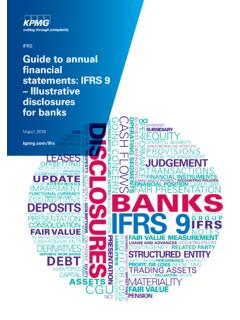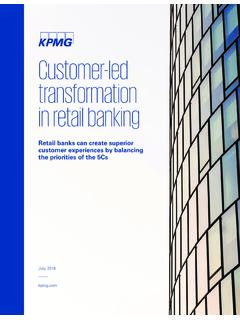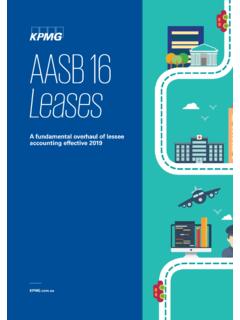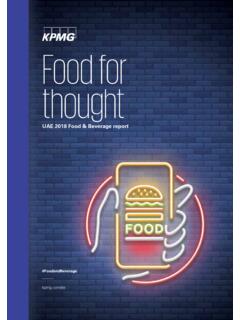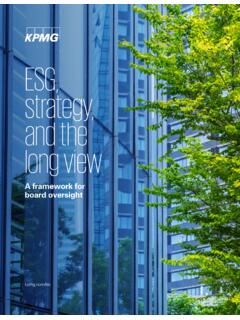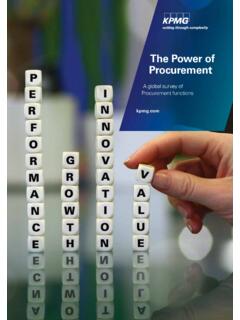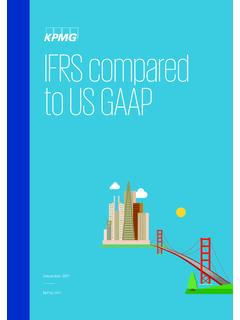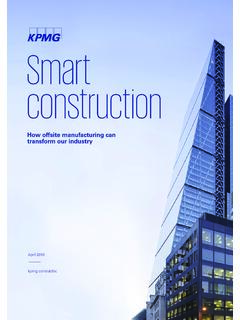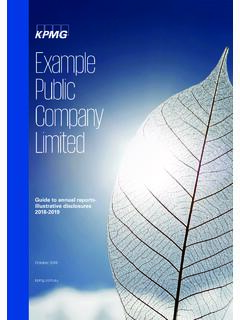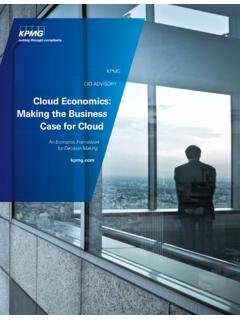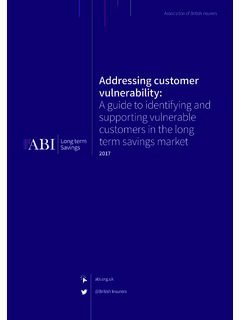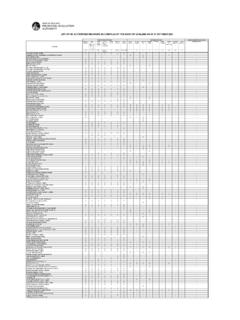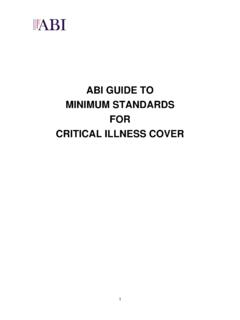Transcription of Pharma outlook 2030: From evolution to revolution
1 KPMG outlook 2030: From evolution to revolutionA shift in focusGlobal Strategy GroupPharma 2030 outlookThe pharmaceutical sector is at a crossroads. In a heavily disrupted marketplace, characterized by shifting payer attitudes and patient empowerment, neither incremental adjustments nor steady evolution are likely to halt the decline of the traditional pharmaceutical business paper looks ahead to a 2030 scenario to examine the trends revolutionizing the sector; trends that we expect to have dramatic believe revenues will fall well short of forecasts as current projections, as well as business and operating models, do not reflect the turbulence in the marketplace.
2 The continued upheaval will give rise to three distinct pharmaceutical archetypes. Executive teams need to carefully consider what type of company they want to be and plot the optimal path towards this preparing for this future now, organizations not only reduce the risk of decreasing income, but can also open up new opportunities for growth. Over the coming months, we shall produce a series of thought-provoking articles that will examine more deeply specific topics outlined in this paper, which sets the scene for volatile times the read!
3 2017 KPMG International Cooperative ( KPMG International ), a Swiss entity. Member firms of the KPMG network of independent firms are affiliated with KPMG International. KPMG International provides no client services. No member firm has any authority to obligate or bind KPMG International or any other member firm vis- -vis third parties, nor does KPMG International have any such authority to obligate or bind any member firm. All rights StirlingPartnerGlobal Chair, Life SciencesRoger van den HeuvelPartner, Head of Life SciencesGlobal Strategy Group2 Pharma 2030: From evolution to revolutionPharma 2030 outlookMany of the developments in the pharmaceutical industry mirror those in the automotive sector.
4 Like pharmaceuticals, the industry is relatively mature and made up of a few major players. And automakers also face intense pressure from regulators in their case to cut emissions, accelerating the move toward electric and other non-polluting vehicles. The growing dependence upon technology, primarily software, is attracting the interest of new entrants such as Google, Uber and Tesla who are focusing on mobility, rather than on the automotive industry with the automotive industry Anyone taking a cursory glance at current pharmaceutical industry revenue forecasts could be forgiven for thinking that all is well.
5 However, the assumptions behind these numbers do not adequately take into account two seismic shifts that are disturbing the industry status quo. The first shift is in the balance of power across the healthcare value chain, as governments and insurers take center stage, pressuring pharmaceutical companies to reduce prices and demonstrate greater value from their therapies. Secondly, we believe a swing from treatment to prevention, diagnostics and cure, will grow stronger in time, attracting a host of new entrants from within and outside of the shifts 2017 KPMG International Cooperative ( KPMG International ), a Swiss entity.
6 Member firms of the KPMG network of independent firms are affiliated with KPMG International. KPMG International provides no client services. No member firm has any authority to obligate or bind KPMG International or any other member firm vis- -vis third parties, nor does KPMG International have any such authority to obligate or bind any member firm. All rights 2030: From evolution to revolution 2017 KPMG International Cooperative ( KPMG International ), a Swiss entity. Member firms of the KPMG network of independent firms are affiliated with KPMG International.
7 KPMG International provides no client services. No member firm has any authority to obligate or bind KPMG International or any other member firm vis- -vis third parties, nor does KPMG International have any such authority to obligate or bind any member firm. All rights 1: Downward pressure on pricingWith rising demand for healthcare and falling budgets, governments and payers are exerting pressure to drive down prices. One bold example involves the Netherlands. Not content with striking volume deals with the major pharmaceutical players, it is looking to utilize the power of the EU to create even greater economies of scale.
8 At the moment, several member states are pooling together into a single procurement machine with much greater bargaining This initiative, in its early stages, is also being looked at by other states seeking to cut their drug governments, insurers and patients are requiring greater transparency around drug pricing. The time-honored healthcare principle of fee-for-service is also under attack. Payers, insurers and hospitals are no longer willing to pay simply for a product push approach; they want fees to be dependent upon the success of the products and procedures through measurable May 2016, US-based health insurer Cigna announced value-based contracts with Sanofi, Regeneron and Amgen for cholesterol lowering drugs, with the insurer receiving discounts if cholesterol levels are not sufficiently reduced following the Another US system Harvard Pilgrim Health Care has signed a value-based contract with Lilly for its diabetes drug, Trulicity, with rebates for under-performance.
9 And an incentive program for exceeding patient , New York State s Delivery System Reform Incentive Payment has the ambitious aim of moving 80 90 percent of managed care payments to value-based methodologies by 2020 a policy that will have a significant knock-on effect for drug Also in the US, The Health Care Transformation Task Force made up of providers, insurers and employers has committed to shift 75 percent of its members business into contracts with incentives for health outcomes, quality and cost management by January of the challenges facing drug manufacturers is to build closer relationships with patients.
10 This has many benefits including better understanding of patient experience and improved adherence. However, the industry has some way to go to become a trusted part of the healthcare value-based pricing (VBP) comes with its fair share of risks and challenges, as evidenced by Novartis Entresto drug, there is large potential to create a win-win situation for multiple healthcare stakeholders if structured and implemented KPMG s white paper, Value-based pricing in pharmaceuticals: Hype or hope? 7 we explore in greater detail some of the challenges of introducing a value-based pricing 2030: From evolution to revolutionCatalyzed by an exciting range of new, disruptive technologies, the pharmaceutical industry needs to reimagine its future.
